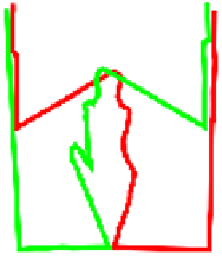Information Technology Reference
In-Depth Information
1
60
s
, we get two signals
d
t
(
θ
) covering the quarter area of a plane, one
per sensor, and apply a polar transformation to them. Then we connect succes-
sive points with straight line segments and register the two signals according to
the width of the frame of the door. This process is illustrated in Figure 3.
Every
Fig. 3.
Construction of a curve per sensor that corresponds to the closest visible points.
The signal captured by the left (right) sensor is displayed in green (red).
Thanks to the calibration of the sensors and the real physical distances they
deliver, the registration process is simple as it relies exclusively on the physical
dimensions of the door. Note however that since the signals provided by the
two sensors are not synchronized, the registration of the sensor signals will be
affected by a time jitter that impacts on the overall signal to noise ratio.
Flood fill and intersection.
For each laser scanner, we now have a continuous
line that outlines one side of the silhouette of the object seen in the curtain. We
still need to reconstruct one complete silhouette. The reconstruction of a half
silhouette is achieved by closing the contour and applying a flood fill algorithm to
the continuous line that outlines it. Then the two half silhouettes are intersected
to get the silhouette. The reconstruction process is illustrated in Figure 4.
We can see that the upper parts of the silhouette (in principle, the shoulders
and the head) are better represented than the lower parts of the silhouette
because the lasers are closer to the upper part and thus do sample this part of
the shape with a higher precision. As a matter of fact, the legs are almost absent
from the reconstructed silhouettes. Furthermore, we showed in Section 2.2 that
the lack of synchronization of the sensors causes an horizontal imprecision that
decreases with the height of a point.
The reconstruction of a silhouette happens 60 times per second. Figure 5
shows a 3D volume obtained by piling up the successive silhouettes of one (left-
hand side picture) or two (right-hand side picture) persons while they cross the
curtain. This 3D shape is not very intuitive. Therefore we need to elaborate on
the appropriate features to describe it.




Search WWH ::

Custom Search